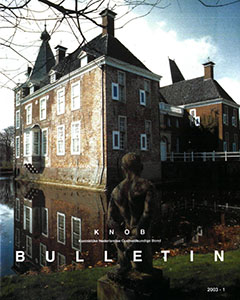Indexering ESCI / Scopus


Toelichting themanummer Platform Mariaplaats. Annemieke Kylstra-Wielinga: De jas van het onderzoek ofwel de weg naar het behoud van onze monumenten. Wim Meulenkamp, Eric Blok en Theo Wit: De cementrustieke brug van kasteel De Haar, een gemiste kans. Jan van der Hoeve: Het Blokhuis te Harlingen, Weeshuisstraat 1. Dirk J. de Vries: Onbekend erfgoed in het buitengebied en de voorsteden. Flora van Regteren Altena: Historische Behangsels: een teken aan de wand. Jean Penders: Wie weet is het halve werk al gedaan. Wordt het Utrechts Documentatiesysteem een nationaal kennisinstituut?
In the Netherlands a lot of matters are made subordinate to economic interests and the urge for economic progress is imperative. Culture must be economised. In addition, the large number of infrastructural measures, taken by the authorities in order to clear the way for passenger travel and goods transport, pose a threat to this part of our cultural heritage. This fate does not only affect the visible monuments.
Things are even worse for non-visible monuments, such as castle grounds, frequently without protected status, as well as for the non-protected direct surroundings of a...
No doubt the intention was good. However, the result turned out much less favourably. In the year 1996 the cement-rustic bridge at Bochtdijk in the park of De Haar Castle was restored. It had the appearance of a bridge made of tree-trunks, a frequently used technique in the nineteenth century and the beginning of the twentieth century.
It looked as if a lorry had bumped into it a very long time ago, and had damaged the right-hand side. However, the iron in the cement may have started to 'work', a frequently occurring problem.
The 'restoration' was very rigorous indeed....
On the occasion of the demolition plans for the boarding school of the Noordzeecollege a building-historical research took place in two phases. It was established that the oldest part of the complex was built in 1500, probably as a warehouse building on the blockhouse. The blockhouse was a rectangular fortress measuring approximately 115 x 145 metres with revetted earth ramparts and two round bastions.
The bastion on the south-east side was a later addition. Within the fortress there were various buildings around a parade ground. In the Eighty Years' War the blockhouse was...
As elsewhere in the Netherlands, along the old country roads and waterways at the city entrances Zwolle and Utrecht know suburbs that date back to the Middle Ages. Little is known about the nature of the buildings and - unlike the city centres - hardly any building historical research is being done on this subject.
In Utrecht and Amsterdam we found older agricultural buildings in 19th-century urban-development districts. These outlying districts prove to be older and as regards buildings more varied in age than they would seem at first sight. The examples also show that it is...
The aim of the Foundation for Historical Wallpapers and Wall decorations in the Netherlands SHBW is to give greater publicity to the beauty and value of historical wallpapers, to increase knowledge in this field and thus to stimulate conservation.
The SHBW manages and opens up a large collection of used wallpapers, which was built up over many years. In a general sense the SHBW is asking attention for historical wallpapers, which are still regularly found in old houses, but are also delicate and may easily disappear during renovations and refurbishments.
With an...
Half the time available for a research is often spent on trying to figure out what later on appears to have been known for a long time. The Utrecht Documentation System (UDS) was set up as a very special extra access to the information that is scattered in many places. Although the set-up is intended for the entire Netherlands, the system contains a lot of information on the city of Utrecht in particular.
An example. At the end of the 19th century Lange Viestraat in Utrecht was widened on the north side and in the thirties of the 20th century on the south side; this causes...


open access mogelijk gemaakt door Stichting OpenAccess
